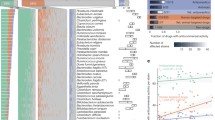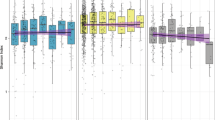Abstract
Our knowledge regarding the interplay between drugs, our microbiome, and the host has long been restricted to a few exceptional cases. Recent evidence from more systematic studies reveals that the majority of commonly used drugs underlie such interactions. This highlights the need for a more comprehensive understanding of the interface between pharmacology, microbial ecology, environmental factors, and the host genotype.
Similar content being viewed by others
Literatur
Blaser M (2016) Antibiotic use and its consequences for the normal microbiome. Science 352:544–545
Le Bastard Q, Al-Ghalith GA, Gregoire M et al. (2018) Systematic review: human gut dysbiosis induced by nonantibiotic prescription medications. Aliment Pharmacol Ther 47:332–345
Tramontano M, Andrejev S, Pruteanu M et al. (2018) Nutritional preferences of human gut bacteria reveal their metabolic idiosyncrasies. Nat Microbiol 3:514–522
Maier L, Pruteanu M, Kuhn M et al. (2018) Extensive impact of non-antibiotic drugs on human gut bacteria. Nature 555:623–628
Maier L, Typas A (2017) Systematically investigating the impact of medication on the gut microbiome. Curr Opin Microbiol 39:128–135
Spanogiannopoulos P, Bess EN, Carmody RN et al. (2016) The microbial pharmacists within us: a metagenomic view of xenobiotic metabolism. Nat Rev Microbiol 14:273–287
Sousa T, Yadav V, Zann V et al. (2014) On the colonic bacterial metabolism of azo-bonded prodrugsof 5-aminosalicylic acid. J Pharm Sci 103:3171–3175
Haiser HJ, Seim KL, Balskus EP et al. (2014) Mechanistic insight into digoxin inactivation by Eggerthella lenta augments our understanding of its pharmacokinetics. Gut Microbes 5:233–238
Wallace BD, Wang H, Lane KT et al. (2010) Alleviating cancer drug toxicity by inhibiting a bacterial enzyme. Science 330:831–835
Zimmermann M, Zimmermann-Kogadeeva M, Wegmann R et al. (2019) Mapping human microbiome drug metabolism by gut bacteria and their genes. Nature 570:462–467
Pryor R, Martinez-Martinez D, Quintaneiro L et al. (2019) The role of the microbiome in drug response. Annu Rev Pharmacol Toxicol 6, doi: 10.1146/annurev-pharmtox-010919-023612
Elkrief A, Derosa L, Zitvogel L (2019) The intimate relationship between gut microbiota and cancer immunotherapy. Gut Microbes 10:424–428
Lam KN, Alexander M, Turnbaugh PJ (2019) Precision medicine goes microscopic: engineering the microbiome to improve drug outcomes. Cell Host Microbe 26:22–34
Author information
Authors and Affiliations
Corresponding author
Additional information
Lisa Maier 2004–2009 Biochemiestudium an der Universität TÜbingen. 2010–2013 Promotion bei Prof. W.-D. Hardt an der ETH ZÜrich, Schweiz; dort 2014 Postdoc. 2015-2018 Postdoc am EMBL in Heidelberg bei Dr. A. Typas (EIPOD-Programm). Seit 2019 Gruppenleiterin an der Universität TÜbingen, Exzellenzcluster EXC 2124, Aufnahme in das Emmy-Noether-Programm der DFG
Rights and permissions
About this article
Cite this article
Maier, L. Komplexe Wechselwirkungen zwischen Arzneimitteln und dem Mikrobiom. Biospektrum 25, 707–710 (2019). https://doi.org/10.1007/s12268-019-1302-9
Published:
Issue Date:
DOI: https://doi.org/10.1007/s12268-019-1302-9




